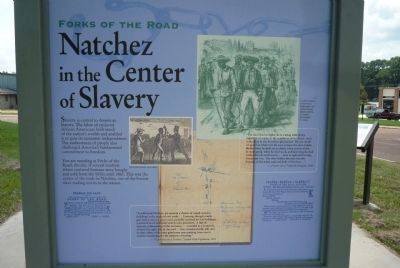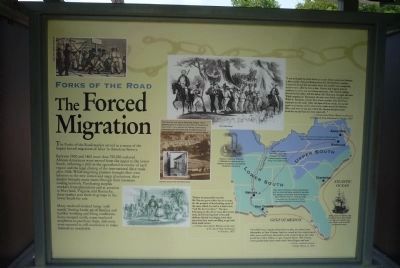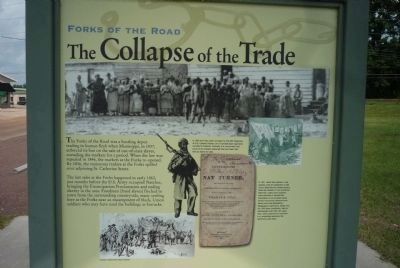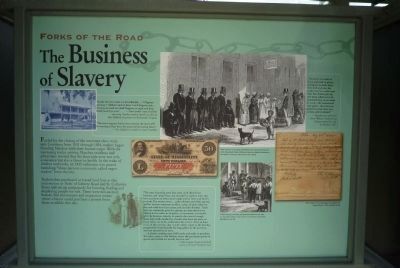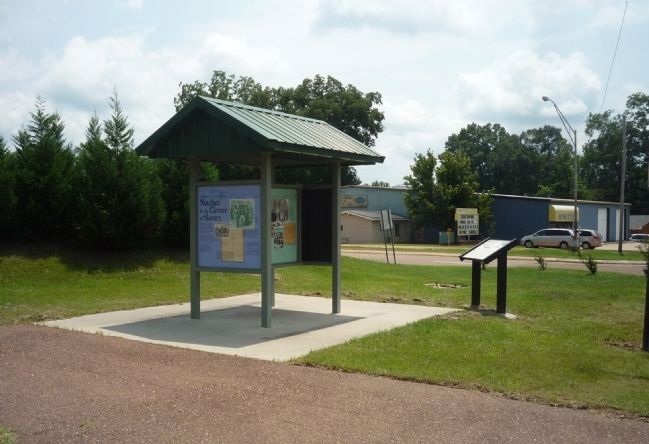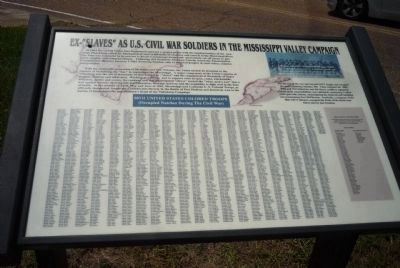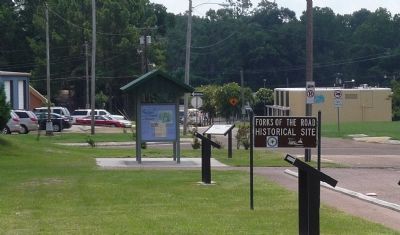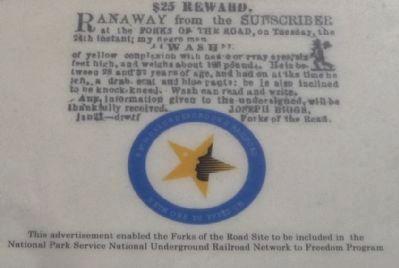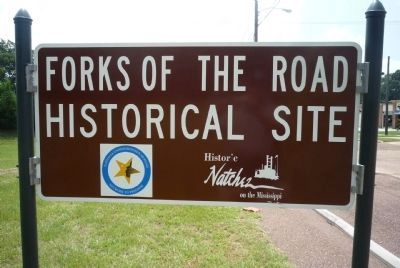Natchez in Adams County, Mississippi — The American South (East South Central)
Forks of the Road Historical Site
Inscription.
[Panel 1:]
Natchez in the Center of Slavery
Slavery is central to American history. The labor of enslaved African Americans built much of the nation’s wealth and enabled it to gain its economic independence. The enslavement of people also challenged America’s fundamental commitment to freedom.
You are standing at Forks of the Road, the site of several markets where enslaved humans were bought and sold from the 1830s until 1863. This was the center of the trade in Natchez, one of the busiest slave trading towns in the nation.
[Two printed announcements for slave sales at Forks of the Road, left and right]
[Caption for drawing, upper right:]
A coffle of slaves in downtown Washington, DC. Traders bound slaves together in “coffles” for transport to market.
“The slave has no rights; he is a being with all the capacities of a man in the condition of a brute. Such is the slave in the American plantations. He can decide no question relative to his own actions; the slave-holder decides what he shall eat or drink, when and to whom he shall speak, when he shall work, and how long he shall work; when he shall marry ... what is right and wrong, virtue and vice. The slave-holder becomes the sole disposer of the mind, soul and body of his slave ...” – Former slave Frederick Douglass, 1846.
“A mile from Natchez, we came to a cluster of rough wooden buildings in the angle of two roads ... Entering though a wide gate into a narrow court-yard, partially enclosed by low buildings, a scene of novel character was at once presented. A line of negroes, commencing at the entrance ... extended in a semicircle around the right side of the yard ... they stood perfectly still, and in close order, while some gentlemen were passing from one to another examining for the purpose of buying.” ”Southwest by a Yankee,” Joseph Holt Ingraham, 1834.
[Quotation over a hand-drawn, antebellum map of the Forks of the Road neighborhood from the Mississippi Department of Archives and History.]
[Panel 2:]
The Forced Migration
The Forks of the Road market served as a nexus of the largest forced migration of labor in American history.
Between 1800 and 1860 more than 750,000 enslaved African-Americans were moved from the upper to the lower South, reflecting a shift in the agricultural economy of each region and the legal closing of the international slave trade after 1808. While migrating planters brought their own laborers to the new cotton and sugar plantations, slave dealers brought many more through their interstate trading network. Purchasing surplus workers
from plantations and at auctions in Maryland, Virginia, and Kentucky, these traders sent them in groups to the lower South for sale.
Many enslaved resisted being ‘sold south,’ fearing break-up of families and harsher working and living conditions. Some escaped north, some implored neighbors to purchase them, and some even resorted to self-mutilation to make themselves unsaleable.
[Background illustrations and captions:]
[Upper left: Enslaved Black Americans being marched to a ship by White men with whips. East Carolina University Joyner Library]
[Upper middle and right: “The Coffle Gang” (Black Americans with shackled wrists being marched overland by mounted White men with whips - fiddle players and a large American flag in column.]
“I was at length knocked down, to a man whose name was Denton, a slave trader, then purchasing slaves for the Southern market...and we were called to form a line. Horses and wagons were in readiness to carry our provisions and tents... Mr. Denton taking the lead in his sulky; and the driver, Mr. Thornton, brought the rear. While stopping [in Tennessee], the men were hired to pick cotton. While in Tennessee, we lost four of our number, who died from exposure on the road. After the lapse of three weeks, we started again our journey, and in about four weeks arrived in Natchez, Miss.,
and went to our pen which Mr. Denton had previously hired for us; and had our irons taken off. ...” –Former slave Henry Watson on the start of his march from Richmond to Natchez, 1827.
[Center middle:] The slave pen and yard at Alexandria, Virginia, was a gathering point for coffles and shipments of slaves to the lower South, many destined for Natchez. Slave-trading businesses such as Franklin and Armsfield involved one partner gathering slaves in Alexandria and another selling them in Natchez. Insert photo courtesy of New York Historical Society.
[Lower middle and right:]
“Before we proceeded very far, Mr. Denton gave orders for us to stop, for the purpose of handcuffing some of the men, which, he said in a loud voice, 'had the devil in them.' The men belonging to this drove were all married men, and all leaving their wives and children behind: he judging from their tears that they were unwilling to go, had them made secure."
–Former slave Henry Watson on the start of his march from Richmond to Natchez, 1827.
“Armfield was a regular slave trader, run slaves from Alexandria to New Orleans, had two vessels in that employment, when one would leave Alexandria with a load of slaves the other would leave New Orleans to get a load of slaves. This I know, I have passed them more times than I
have fingers and toes.” – Former enslaved seaman, George Henry, ca. 1834.
[Captions overlaying a map of the southeastern U.S. with internal slave trade routes indicated; lower right:]
Closing off imports from Africa after 1808 increased the price of enslaved people already living in the upper South.
New crops in Kentucky, Virginia and Maryland such as wheat and hemp required far less labor than tobacco. At the same time, the acreage of labor intensive crops of cotton and sugar expanded with the opening of Native American homelands in the lower South.
Floating or steaming down river of flatboats and steamboats from Kentucky and Missouri was relatively inexpensive and speedy.
Sailing down the Atlantic coast, across the Gulf to New Orleans and upriver to Natchez was very fast and cost about $20 per enslaved person.
The overland route from Virginia to Natchez was the least expensive but arduous on all who walked.
[Panel 3:]
The Collapse of the Trade
The Forks of the Road was a bustling depot trading in human flesh when Mississippi, in 1837, enforced its ban on the out-of-state slaves, curtailing the markets for a period. When the law was repealed in 1846, the markets at the Forks re-opened. By 1856, the numerous traders at the Forks spilled over adjoining St. Catherine Street.
The last sales
at the Forks happened in early 1863, just months before the U.S. Army occupied Natchez, bringing the Emancipation Proclamation and ending slavery in the area. Freedmen (freed slaves) flocked to town from the surrounding countryside, many settling here at the Forks near an encampment of black, Union soldiers who may have used the buildings as barracks.
[Caption beneath images of freedmen: a photo of settlers in Natchez(?), engravings of a Black Union soldier and encamped women and children, and a sketch of freed families on the move (courtesy of Historic New Orleans Collection).]
In 1863 the Forks were occupied by the 58th Regiment of U.S. Colored Infantry, one of several black regiments recruited in Natchez. Ironically, it is conceivable that some of the soldiers here had been held here as slaves for sale.
[Title page of: The Confessions of Nat Turner, ... as fully and voluntarily made to Thomas R. Gray ... 1832.]
In 1831, about forty slaves in rural Virginia under the leadership of Nat Turner killed fifty-five whites during a three-day rebellion. In the emotional aftermath, nearly every southern state restricted or banned the importation of out-of-state slaves, fearing introduction of violence-prone slaves onto local plantations. Mississippi’s restrictions, written into the 1832 state constitution, had no enforcement
until 1837. Ten years later, under pressure for more labor in an expanding economy, the restrictions were lifted.
[Panel 4:]
The Business of Slavery
Fueled by the closing of the interstate slave trade into Louisiana from 1831 through 1834, traders began flooding Natchez with their human cargo. With the increasing trader activity, Natchez residents and physicians warned that the slave jails were not only a nuisance but also a threat to health. In the wake of cholera outbreaks, an 1833 ordinance was passed banishing “those persons commonly called negro traders” from the city.
Traders then purchased or leased land here at this intersection or ‘fork’ of Liberty Road and St. Catherine Street and set up compounds for housing, feeding and displaying people for sale. These were not auction houses, but showrooms and inspection rooms where a buyer could purchase a person from those available that day.
[Photo, upper left:] This slave hospital was located on St. Catherine Street near the Forks of the Road.
“In the last two weeks we have Buried … 9 Negroes and 6 or 7 children and we have 7 or 8 Negroes sick … the way we send out dead Negroes at night and keep Dark [secret] is a sin.” --Slave trader Isaac Franklin reporting Natchez cholera deaths in 1832 to Rice Ballard, his partner in Richmond, Virginia.
“The more negroes lost in that country the more will be wanting if they have the means of procuring them.” Rice Ballard in a letter to Isaac Franklin
“The men dressed in navy blue suits, with shiny brass buttons, and “plug” hats, was intended to capture most any boys attention; as they march single and by two’s and three’s in circle. The women wore … calico dresses, and white aprons, and for further ornament & effect, a piece of pink ribbon at the neck with their hair matty, and carefully braided. There were no commands given by anyone, no noise about it no talking in the ranks, no laughter, or merriment, connected with the business, silently, & quietly, they went through those daily drills, headed by a leader who knew his place, as every other one in the ranks knew his or hers. After an hour or so, of this exercise, they would orderly repair to the benches, prepared for them beneath the long gallery at the quarters, and seat themselves in rows. … A planter needing more field hands, and ready to purchase the same, comes to this Market, where this particular species of goods and chattels are usually kept for sale.”
-- Felix Eugene Houston Hadsell courtesy of Isabel Hadsell Linch.
[Illustrations, center right:]
[“T. Hart Slaves”] Well dressed for a good presentation
and sale, the enslaved often discarded these clothes as soon as possible because of the stigma of being recently from the market.
“The slaves are made to shave and wash in greasy pot liquor, to make them look sleek and nice; the heads must be combed and their best clothes put on; and when called out to be examined they are to stand in a row – the women and men apart – then they are picked out and taken into a room, and examined.”
--Recollection of former slave William Anderson on being prepared for sale in Natchez, 1827.
$50.00 Mississippi Treasury Note [with renderings of enslaved Black cotton workers]. Mississippi Department of Archives and History.
While Forks of the Road became the center for the sale of “imported” slaves, local slaves could still be purchased throughout the city.
Bill of Sale for the “purchase of a negroe boy named Royal,” 1832, Adams County.
Erected 2004 by Historic Natchez on the Mississippi.
Topics. This historical marker is listed in these topic lists: African Americans • Agriculture • Industry & Commerce • War, US Civil. A significant historical year for this entry is 1863.
Location. 31° 33.334′ N, 91° 23.033′ W. Marker is in Natchez
, Mississippi, in Adams County. Marker is on Liberty Road south of St. Catherine St. (U.S. 61), on the right when traveling north. Marker Panels are in the open shelter at the south end of the Forks of the Road Historical Site - on the east side of Liberty Street, just north of eastbound US 61. Touch for map. Marker is in this post office area: Natchez MS 39120, United States of America. Touch for directions.
Other nearby markers. At least 8 other markers are within walking distance of this marker. Ex-"Slaves" as U.S. Civil War Soldiers in the Mississippi Valley Campaign (a few steps from this marker); Forks of the Road (within shouting distance of this marker); a different marker also named Forks of the Road (about 300 feet away, measured in a direct line); History of St. Catherine Street (about 400 feet away); America's Domestic "Slave" Trading Routes To The Deep South (about 500 feet away); Natchez Chapter (approx. ¼ mile away); Monmouth: Upstairs, Downstairs (approx. ¼ mile away); Music on St. Catherine Street (approx. ¼ mile away). Touch for a list and map of all markers in Natchez.
Related markers. Click here for a list of markers that are related to this marker. To better understand the relationship, study each marker in the order shown.
Also see . . . "New Signpost at Slavery's Crossroads". New York Times website entry (12/16/04) (Submitted on April 9, 2011, by Richard E. Miller of Oxon Hill, Maryland.)
Additional keywords. U.S. Colored Troops; USCT; Natchez Trace; human trafficking.
Credits. This page was last revised on June 2, 2023. It was originally submitted on April 8, 2011, by Richard E. Miller of Oxon Hill, Maryland. This page has been viewed 2,097 times since then and 74 times this year. Photos: 1, 2, 3, 4, 5, 6, 7. submitted on April 8, 2011, by Richard E. Miller of Oxon Hill, Maryland. 8, 9. submitted on April 9, 2011, by Richard E. Miller of Oxon Hill, Maryland. • Craig Swain was the editor who published this page.
